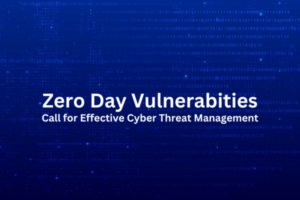The Rise of Zero-Day Vulnerabilities: A Call For Effective Cyber Threat Management
Lalit Ahluwalia is committed to redefining the future of Cybersecurity by adding a “T-Trust” tenet to the conventional CIA Triad. Here, Lalit addresses the question of whether attack surface management is only confinLalit Ahluwalia is committed to redefining the future of Cybersecurity by adding a “T-Trust” tenet to the conventional CIA Triad. Here, Lalit explores zero day vulnerabilities and their consequences, plus the need for effective cyber threat management.ed to the surface, and introduces “DigitalXForce” as a cybersecurity solution that goes beyond the surface to secure digital assets of organizations.

Are you aware that in today’s digital age, where technology is advancing at an astonishing pace, cyber threats are evolving just as quickly? You might think you’re safe behind your computer screen, but the rise of zero-day vulnerabilities has left even the most tech-savvy individuals vulnerable to cyber attacks.
In this article, we will explore the dangers of zero-day vulnerabilities and emphasize why you should prioritize effective cyber threat management. So, get ready to embrace some tough realities and protect your organization.
Understanding Zero-Day Vulnerabilities
What is a zero-day vulnerability? To answer this question, picture this: You’re browsing the internet, going about your usual online activities, completely unaware that lurking in the depths of the web are hidden vulnerabilities, waiting to be exploited. These vulnerabilities, known as zero-day vulnerabilities, are software flaws that are unknown to the vendor and, therefore, unpatched.
Hackers exploit these vulnerabilities to gain unauthorized access to your devices, steal your sensitive information, or even hijack your systems for their malicious purposes.
Why Should You Take Zero-Day Vulnerabilities Seriously?
Now, let’s talk about the real dangers you face and why you should take zero-day vulnerabilities seriously. Zero-day vulnerabilities are like silent assassins, waiting for the perfect moment to strike. They give hackers an edge – an advantage over you, the unsuspecting victim. Because these vulnerabilities are unknown to software developers, there are no patches or fixes available to protect you.
This means that once a zero-day vulnerability is exploited, you’re left defenseless, with little to no time to react or protect yourself.
The Consequences of a Zero-Day Attack
Imagine waking up one morning, only to find that your bank account has been drained, your personal emails have been exposed, or worse, your identity has been stolen. The consequences of a successful zero-day attack can be devastating.
It’s not just individuals who suffer; businesses, government organizations, and even critical infrastructure can be crippled by these attacks. The financial and reputational damage can be irreparable, leaving you in a state of vulnerability and despair.
The Increasing Sophistication of Attacks
You might think that staying up to date with the latest antivirus software or using strong passwords will keep you safe. Unfortunately, it’s not that simple. Hackers are constantly evolving their tactics, making their attacks more sophisticated and difficult to detect.
They are using advanced techniques, such as social engineering, spear-phishing, and even artificial intelligence, to exploit zero-day vulnerabilities.
It’s like a never-ending game of cat and mouse, with you as the mouse, desperately trying to stay one step ahead.
The Need for Effective Cyber Threat Management
Now that you understand the gravity of the situation, it’s time to take action. Effective cyber threat management is the key to safeguarding yourself against zero-day vulnerabilities.
It’s not just about relying on software updates; it’s about adopting a proactive approach and implementing a comprehensive cybersecurity strategy.
Here are a few essential steps you can take to protect yourself:
- Stay Informed: Regularly educate yourself about the latest cyber threats and vulnerabilities. Follow reputable cybersecurity news sources, attend webinars, and participate in workshops to enhance your knowledge.
- Update and Patch: Ensure that all your software, operating systems, and applications are up to date with the latest patches. Vendors often release security updates to address newly discovered vulnerabilities.
- Invest in Robust Security Solutions: Install reputable antivirus software, firewalls, and intrusion detection systems. These tools act as your first line of defense against cyber attacks.
- Implement Strong Authentication Practices: Use complex, unique passwords for all your online accounts, and consider using multi-factor authentication whenever possible. This makes it significantly more challenging for hackers to gain unauthorized access.
- Practice Safe Browsing Habits: Be cautious when clicking on links or downloading files from unknown sources. Avoid suspicious websites and refrain from opening emails or attachments from untrusted senders.
- Regularly Backup Your Data: In the event of a successful cyber attack, having recent backups of your data can be a lifesaver. Invest in a reliable backup solution and make it a habit to back up your important files regularly.
Conclusion
The rise of zero-day vulnerabilities has made it clear that no one is safe from the ever-evolving cyber threats of the digital world. By following the steps outlined in this article, you can take a proactive stance in protecting yourself against these malicious attacks.
Remember, effective cyber threat management is not just an option; it’s a necessity in today’s interconnected world. Stay informed, stay vigilant, and be prepared to defend yourself against the unseen dangers that lurk in cyberspace.